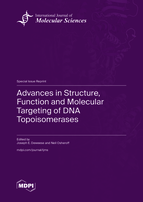Advances in Structure, Function and Molecular Targeting of DNA Topoisomerases
A special issue of International Journal of Molecular Sciences (ISSN 1422-0067). This special issue belongs to the section "Molecular Biology".
Deadline for manuscript submissions: closed (15 June 2023) | Viewed by 20603
Special Issue Editors
2. Adjunct Associate Professor, Biochemistry Department, Vanderbilt University, Nashville, TN 37232, USA
Interests: DNA topoisomerases
Special Issues, Collections and Topics in MDPI journals
Interests: topoisomerase
Special Issues, Collections and Topics in MDPI journals
Special Issue Information
Dear Colleagues,
Topoisomerases are essential enzymes in living systems playing critical roles in transcription, replication, cell division, and DNA damage repair. Work over the last 45+ years has elucidated many facets of the function of these enzymes, but critical questions remain. Although work has been completed on some fundamental questions of function and mechanism, additional questions related to regulation, localization, and protein–protein interactions have been raised. Further, the utility of anticancer and antibacterial drugs targeting topoisomerases have been widely recognized, and many chemotherapeutic regimens still include topoisomerase poisons. Thus, work must continue to explore both the available agents and in identifying new ones.
This Special Issue of the International Journal of Molecular Sciences focuses on topoisomerases, and welcomes both original research articles and review papers that deal with advances in our understanding of topoisomerase structure, function, and molecular targeting for therapeutic purposes.
Prof. Dr. Joseph E. Deweese
Prof. Dr. Neil Osheroff
Guest Editors
Manuscript Submission Information
Manuscripts should be submitted online at www.mdpi.com by registering and logging in to this website. Once you are registered, click here to go to the submission form. Manuscripts can be submitted until the deadline. All submissions that pass pre-check are peer-reviewed. Accepted papers will be published continuously in the journal (as soon as accepted) and will be listed together on the special issue website. Research articles, review articles as well as short communications are invited. For planned papers, a title and short abstract (about 100 words) can be sent to the Editorial Office for announcement on this website.
Submitted manuscripts should not have been published previously, nor be under consideration for publication elsewhere (except conference proceedings papers). All manuscripts are thoroughly refereed through a single-blind peer-review process. A guide for authors and other relevant information for submission of manuscripts is available on the Instructions for Authors page. International Journal of Molecular Sciences is an international peer-reviewed open access semimonthly journal published by MDPI.
Please visit the Instructions for Authors page before submitting a manuscript. There is an Article Processing Charge (APC) for publication in this open access journal. For details about the APC please see here. Submitted papers should be well formatted and use good English. Authors may use MDPI's English editing service prior to publication or during author revisions.
Keywords
- topoisomerase
- DNA supercoiling
- DNA topology
- anticancer
- antimicrobial
- DNA damage








